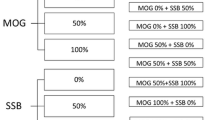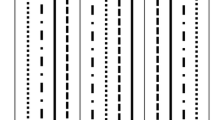Abstract
Smoke was applied to seven different grapevine cultivars (Chardonnay, Sauvignon Blanc, Pinot Gris, Pinot Noir, Shiraz, Cabernet Sauvignon and Merlot) for 1 h at approximately 7 days post-veraison. A range of viticultural measurements were subsequently performed to evaluate any effects on crop yield, vegetative growth and vine physiology. Few significant differences in berry growth or maturation (as sugar accumulation), yield or vine growth were observed between control and smoke-affected grapevines; but the photosynthetic capacity of some varieties, Merlot and Cabernet Sauvignon in particular, decreased significantly following smoke exposure. The extent of smoke taint in the resultant wines was then determined by quantification of volatile phenols and guaiacol glycoconjugates, and by descriptive sensory analysis. Elevated concentrations of volatile phenols and guaiacol glycoconjugates were observed in wines made from smoke-affected grapes; with smoke-affected Pinot Gris and Cabernet Sauvignon wines found to exhibit the most intense smoke-related sensory attributes. The physiological, compositional and sensory consequences of grapevine exposure to smoke were found to vary amongst cultivars, suggesting some grape varieties might be more susceptible to the effects of smoke exposure than others. Further research into the impact of smoke exposure by different cultivars might inform varietal selection in smoke-prone wine regions, in order to mitigate the risk of smoke exposure.



Similar content being viewed by others
References
Bell TL, Stephens SL, Moritz MA (2013) Short-term physiological effects of smoke on grapevine leaves. Int J Wildland Fire 22:933–946
Calder WJ, Lifferth G, Moritz MA, Clair SBS (2010) Physiological effects of smoke exposure on deciduous and conifer tree species. Int J Forestry Res 2010:438930
Dungey KA, Hayasaka Y, Wilkinson KL (2011) Quantitative analysis of glycoconjugate precursors of guaiacol in smoke-affected grapes using liquid chromatography-tandem mass spectrometry based stable isotope dilution analysis. Food Chem 126:801–806
During H (1998) Photochemical and non-photochemical responses of glasshouse-grown grape to combined light and water stress. Vitis 37:1–4
Fudge AL, Ristic R, Wollan D, Wilkinson KL (2011) Amelioration of smoke taint in wine by reverse osmosis and solid phase adsorption. Aust J Grape Wine Res 17:41–48
Fudge AL, Schiettecatte M, Ristic R, Hayasaka Y, Wilkinson KL (2012) Amelioration of smoke taint in wine by treatment with commercial fining agents. Aust J Grape Wine Res 18:302–307
Fuentes S, Sullivan W, Tilbrook J, Tyerman S (2010) A novel analysis of grapevine berry tissue demonstrates a variety-dependent correlation between tissue vitality and berry shrivel. Aust J Grape Wine Res 16:327–336
Gilbert ME, Ripley BS (2003) The effect of smoke on the photosynthetic gas exchange of Chrysanthemoides monilifera. South Afr J Bot 68:525–531
Guehl JM, Aussenac G (1987) Photosynthesis decrease and stomatal control of gas-exchange in Abies-alba mill in response to vapor-pressure difference. Plant Physiol 83:316–322
Hayasaka Y, Baldock GA, Parker M, Pardon KH, Black CA, Herderich MJ, Jeffery DW (2010) Glycosylation of smoke-derived volatile phenols in grapes as a consequence of grapevine exposure to bushfire smoke. J Agric Food Chem 58:10989–10998
Hayasaka Y, Parker M, Baldock GA, Pardon KH, Black CA, Jeffery DW, Herderich MJ (2013) Assessing the impact of smoke exposure in grapes: development and validation of a HPLC-MS/MS method for the quantitative analysis of smoke-derived phenolic glycosides in grapes and wine. J Agric Food Chem 61:25–33
Heath RL (1980) Initial events in injury to plants by air-pollutants. Ann Rev Plant Physiol 31:395–431
Iland PG, Bruer N, Edwards G, Weeks S, Wilkes E (2004) Chemical analysis of grapes and wine: techniques and concepts Adelaide. Patrick Iland Wine Promotions Pty Ltd, Campbelltown
Kelly D, Zerihun A, Hayasaka Y, Gibberd M (2014) Winemaking practice affects the extraction of smoke-borne phenols from grapes into wines. Aust J Grape Wine Res 20:386–393
Kennison KR, Wilkinson KL, Williams HG, Smith JH, Gibberd MR (2007) Smoke-derived taint in wine: effect of postharvest smoke exposure of grapes on the chemical composition and sensory characteristics of wine. J Agric Food Chem 55:10897–10901
Kennison KR, Gibberd MR, Pollnitz AP, Wilkinson KL (2008) Smoke-derived taint in wine: the release of smoke-derived volatile phenols during fermentation of Merlot juice following grapevine exposure to smoke. J Agric Food Chem 56:7379–7383
Kennison KR, Wilkinson KL, Pollnitz AP, Williams HG, Gibberd MR (2009) Effect of timing and duration of grapevine exposure to smoke on the composition and sensory properties of wine. Aust J Grape Wine Res 15:228–237
Kennison KR, Wilkinson KL, Pollnitz AP, Williams HG, Gibberd MR (2011) Effect of smoke application to field-grown Merlot grapevines at key phenological growth stages on wine sensory and chemical properties. Aust J Grape Wine Res 17:S5–S12
Lawless HT, Heymann H (1999) Acceptance and preferance testing. In: Heldman DR (ed) Sensory evaluation of food: principles and practices. International Thomson Publishing, New York, pp 430–479
Mayr CM, Parker M, Baldock GA, Black CA, Pardon KH, Williamson PO, Herderich MJ, Francis IL (2014) Determination of the importance of in-mouth release of volatile phenol glycoconjugates to the flavor of smoke-tainted wines. J Agric Food Chem 62:2327–2336
Parker M, Osidacz P, Baldock GA, Hayasaka Y, Black CA, Pardon KH, Jeffery DW, Geue JP, Herderich MJ, Francis IL (2012) Contribution of several volatile phenols and their glycoconjugates to smoke-related sensory properties of red wine. J Agric Food Chem 60:2629–2637
Pollnitz AP, Pardon KH, Sefton MA (2000) Quantitative analysis of 4-ethylphenol and 4-ethylguaiacol in red wine. J Chromatogr A 874:101–109
Pollnitz AP, Pardon KH, Sykes M, Sefton MA (2004) The effects of sample preparation and gas chromatograph injection techniques on the accuracy of measuring guaiacol, 4-methylguaiacol and other volatile oak compounds in oak extracts by stable isotope dilution analyses. J Agric Food Chem 52:3244–3252
Ristic R, Osidacz P, Pinchbeck KA, Hayasaka Y, Fudge AL, Wilkinson KL (2011) The effect of winemaking techniques on the intensity of smoke taint in wine. Aust J Grape Wine Res 17:S29–S40
Ristic R, Pinchbeck KA, Fudge AL, Hayasaka Y, Wilkinson KL (2013) Effect of leaf removal and grapevine smoke exposure on colour, chemical composition and sensory properties of Chardonnay wines. Aust J Grape Wine Res 19:230–237
Ristic R, Boss PK, Wilkinson KL (2015) Influence of fruit maturity at harvest on the intensity of smoke taint in wine. Molecules 20:8913–8927
Rosen PM, Musselman RC, Kender WJ (1978) Relationship of stomatal resistance to sulfur-dioxide and ozone injury in grapevines. Sci Hortic 8:137–142
Sadras VO, Soar CJ (2009) Shiraz vines maintain yield in response to a 2-4 degrees C increase in maximum temperature using an open-top heating system at key phenostages. Eur J Agron 31:250–258
Saxe H (1986) Effects of NO, NO2 and CO2 on net photosynthesis, dark respiration and transpiration of pot plants. New Phytol 103:185–197
Schultz HR (1992) An empirical-model for the simulation of leaf appearance and leaf-area development of primary shoots of several grapevine (Vitis vinifera L.) canopy-systems. Sci Hortic 52:179–200
Schultz HR, Stoll M (2010) Some critical issues in environmental physiology of grapevines: future challenges and current limitations. Aust J Grape Wine Res 16:4–24
Sepulveda G, Kliewer WM, Ryugo K (1986) Effect of high temperature on grapevines (Vitis Vinifera L.). I. Translocation of 14C-photosynthates. Am J Enol Vitic 37(1):13–19
Shertz RD, Kender WJ, Musselman RC (1980) Effects of ozone and sulfur-dioxide on grapevines. Sci Hortic 13:37–45
Soar CJ, Speirs J, Maffei SM, Penrose AB, McCarthy MG, Loveys BR (2006) Grape vine varieties Shiraz and Grenache differ in their stomatal response to VPD: apparent links with ABA physiology and gene expression in leaf tissue. Aust J Grape Wine Res 12:2–12
Stone H, Sidel JL (2004) Descriptive analysis. In: Taylor SL (ed) Sensory evaluation practices, 3rd edn. Academic Press, San Diego, pp 201–245
Wilkinson KL, Ristic R, Pinchbeck KA, Fudge AL, Singh DP, Pitt KM, Downey MO, Baldock GA, Hayasaka Y, Parker M, Herderich MJ (2011) Comparison of methods for the analysis of smoke related phenols and their conjugates in grapes and wine. Aust J Grape Wine Res 17:S22–S28
Acknowledgments
This research was supported under the Australian Research Council’s Linkage Projects funding scheme (LP0989138); the financial contributions of industry partners are also gratefully acknowledged. Anthea Fudge and Kerry Pinchbeck thank Wine Australia for the provision of research scholarships. The authors would also like to acknowledge: the vineyard owners and managers who participated in the project; the sensory panel for their invaluable contribution to wine sensory evaluation; Andrew Markides of Lallemand, Australia for the provision of yeast and winemaking consumables; Margaux Vigy and Jesse Graffam for technical assistance; and the Australian Wine Research Institute’s Commercial Services Laboratory for GC–MS analysis.
Author information
Authors and Affiliations
Corresponding author
Electronic supplementary material
Below is the link to the electronic supplementary material.
Rights and permissions
About this article
Cite this article
Ristic, R., Fudge, A.L., Pinchbeck, K.A. et al. Impact of grapevine exposure to smoke on vine physiology and the composition and sensory properties of wine. Theor. Exp. Plant Physiol. 28, 67–83 (2016). https://doi.org/10.1007/s40626-016-0054-x
Received:
Accepted:
Published:
Issue Date:
DOI: https://doi.org/10.1007/s40626-016-0054-x




